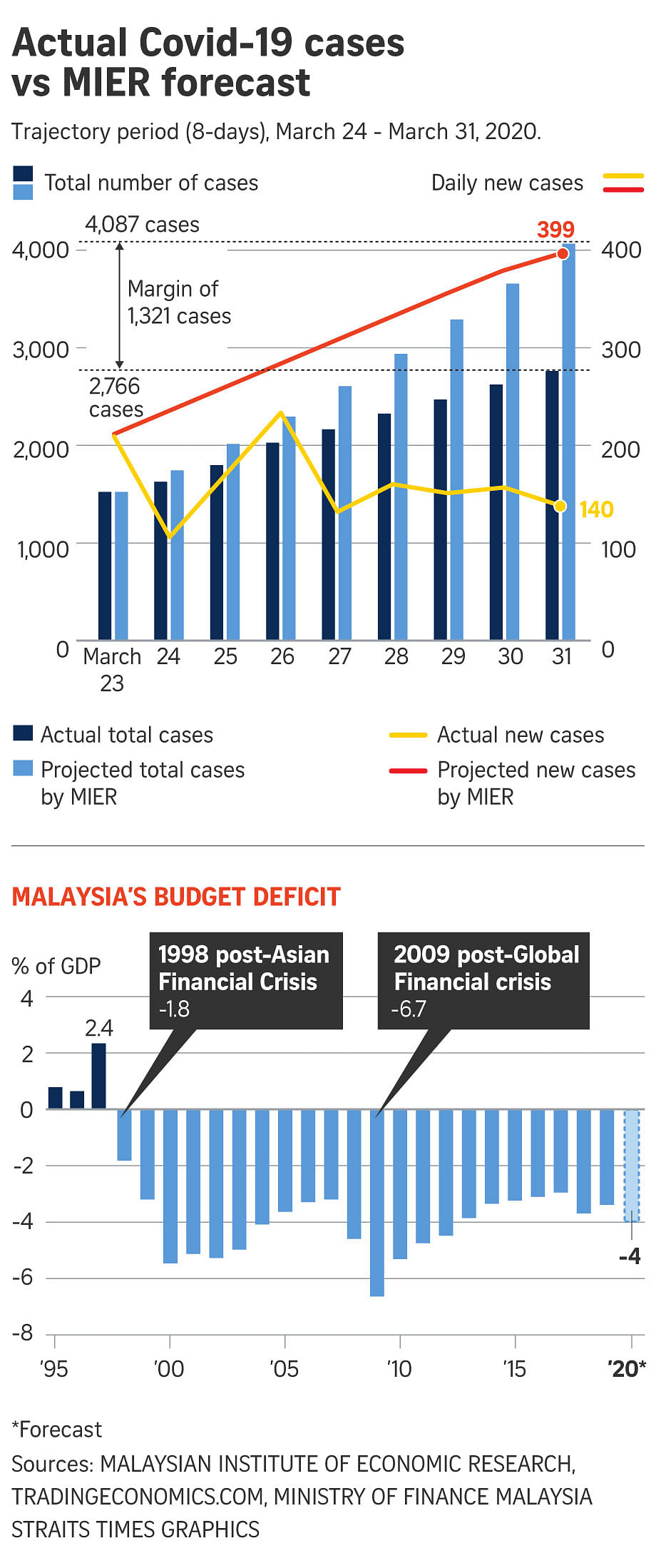KUALA LUMPUR - It was after 8pm last Monday (March 30) when sales promoter Amy Wong found out her apartment at One City Tower would be under an enhanced movement control order (Emco) beginning midnight.
It left her family with no time to save perishables at their grocery stall in the nearby Chow Kit market before 3,200 people in the 502 units of their condominium would effectively be isolated from the rest of the world after 17 residents tested positive for coronavirus.
"Because the government has also ordered that all shops must be closed by 8pm, we did not have an opportunity to store our goods, and it will be a total loss," she told The Straits Times.
Ms Wong, 39, is already on unpaid leave, and now her 62-year-old father and younger brother are also unable to put food on the table during the two weeks of total lockdown.
Thankfully, they have been able to ask her aunt to drop off supplies and food at her home in the usually bustling but now eerily quiet commercial district of Masjid India in Kuala Lumpur, instead of having to rely on government rations of rice, canned food and eggs.
But should the movement control order (MCO) in place since March 18 fail to "flatten the curve", a nationwide Emco could see over 30 million others in Malaysia join the likes of Ms Wong and 10,000 others already in three such areas.
There were 179 new Covid-19 cases reported on Sunday (April 5), bringing the total to 3,662, says the Health Ministry. Four more deaths were recorded, bringing total fatalities to 61.
The number of people who have recovered stood at 1,005, or a recovery rate of 27.4 per cent, said the Health Ministry's director-general, Dr Noor Hisham Abdullah.
Whether broadening the Emco zones, or even calling an outright emergency, becomes necessary is still touch and go.
The number of new infections detected daily since the MCO was declared has oscillated between 100 and 200, aside from a few spikes. Encouragingly, the number of people who have recovered has grown.
While nobody wants to be infected by a potentially fatal disease - Malaysia's mortality rate is 1.6 per cent - a narrowing gap between the rate of infections and the rate of recovery will ease pressure on the healthcare system and allow the government to consider loosening restrictions, or at least not increasing them.

The World Health Organisation's Malaysia, Brunei and Singapore head Ying-Ru Lo was reported by Reuters as saying: "There are initial signs of flattening of the curve, but this could bounce back if control measures are lifted and if people don't continue to take protective measures."
However, to Malaysia's credit, the rate of increase has been slower than projected.
The Malaysian Institute of Economic Research (MIER) forecast on March 23 that the total number of cases would hit 4,087 by the end of the month, but only 2,766 tested positive.
JP Morgan had further estimated in its March 23 report that infections would peak in mid-April at 6,300, a figure Malaysia will miss unless there is a sudden increase.
"These are early signs from the mitigating activities introduced by the ministry and other relevant agencies in the past month," Dr Noor Hisham said on March 31. "However, the next two weeks are crucial. It will decide whether or not the government's MCO has produced the intended impact."
TESTING TIMES
On March 15, the day before Prime Minister Muhyiddin Yassin announced the nationwide travel ban and curbs of non-essential activities, Malaysia recorded a sudden spike of 190 new cases, bringing the total to 428 and making its tally the highest in South-east Asia.
It made great headlines and the country is regularly cited as the worst hit by the virus in the region. But this was a case of bad stats. On paper, Malaysia has a lower per capita infection rate than Singapore.
But the southern neighbour has had a far higher rate of testing at over 7,000 per million compared with Malaysia's figure of about 1,600 so far.
For perspective, Indonesia, widely seen as an example of insufficient testing, had a barely credible 1,986 positive cases as of Friday, less than double Singapore's 1,114. Yet the archipelago had racked up 181 Covid-19 deaths, as compared with the city state's five then.
Several experts believe that in countries where testing is not as widespread as in Singapore and South Korea, the number of positive samples is not a reliable data point for policymaking. Intensive care cases and those resulting in death provide a more accurate picture of domestic outbreaks.

"The way I look at it, death rate is the 'worse-case scenario'. Which should be better for emergency preparedness," Malaysia Medical Gazette managing editor Khoo Yoong Khean told The Straits Times on Saturday, when the toll had hit 57.
He said Malaysians should start worrying if the projected need for hospital beds, intensive care and ventilators exceed capacity.
As of Friday, Health Minister Adham Baba said only 40 per cent of capacity - 6,917 beds and 634 ventilators - earmarked to treat Covid-19 patients was being utilised. Data has also showed that the increase in active hospitalisations is slowing and as of Saturday, only 50 patients were on respiratory support and orders have been placed for 800 more ventilators.
REBOOTING THE ECONOMY
On the other hand, most of the anxiety has been financial, and tighter or prolonged restrictions on business activities will have adverse effects on an economy most are already expecting to dive into recession this year, leaving the Budget 2020 estimate of 4.8 per cent growth seeming like a fantasy in hindsight.
The central bank has since released a revised projection of -2.0 to 0.5 per cent gross domestic product (GDP) growth for the year, far more optimistic than most analysts.
Yet the government has so far been reluctant to spend. It boasts of a RM250 billion (S$82.6 billion) stimulus package of which only 10 per cent is from its own pocket.
Most of this has gone towards direct cash handouts to more than half of Malaysians, as opposed to how other countries have focused on saving jobs by helping employers pay their wage bills.
The government is insisting its deficit will not breach 4 per cent of GDP, despite central bank deputy governor Abdul Rasheed Ghaffour saying on Friday there is "has fiscal space to support the economy during periods of economic slowdown", pointing to how the government deficit rose to 6.7 per cent in 2009 following the global financial crisis.
Instead, the government has been enlarging the definition of "essential services", which are exempted from the economic stasis during the MCO, including even the manufacture of electronics and the entire oil and gas value chain. Less than 30 per cent of nearly 12,000 applications to continue manufacturing have been rejected as of March 30. Despite this, official data shows applications for unemployment benefits are at a record high, tracking at least 60 per cent higher in the past two months as compared to 2019.
Things are set to get worse as seven out of 10 small businesses polled by the Small-Medium Enterprises Association said they will run out of cash by the end of April, leading the group's chief, Mr Michael Kang, to predict that half its members will fold due to the coronavirus and leave a quarter of Malaysia's 16-million-strong labour force on the streets. Unhappy with the stimulus measures announced so far - much has been in the form of loan deferments and cheap credit to ease cash-flow issues - business interests have lobbied the government all week.
"We have collated and considered all feedback, and certain areas have been identified for fine-tuning and improvements," Finance Minister Tengku Zafrul Abdul Aziz said on Saturday, adding that further measures for micro-businesses and SMEs will be announced this week.
By this Friday, the government will also have to decide on whether to extend the MCO.
The Straits Times understands that the health authorities believe this is necessary, but many in the Cabinet want to ease the level of curbs if there is a decline in infections, allowing businesses to awake from hibernation.












